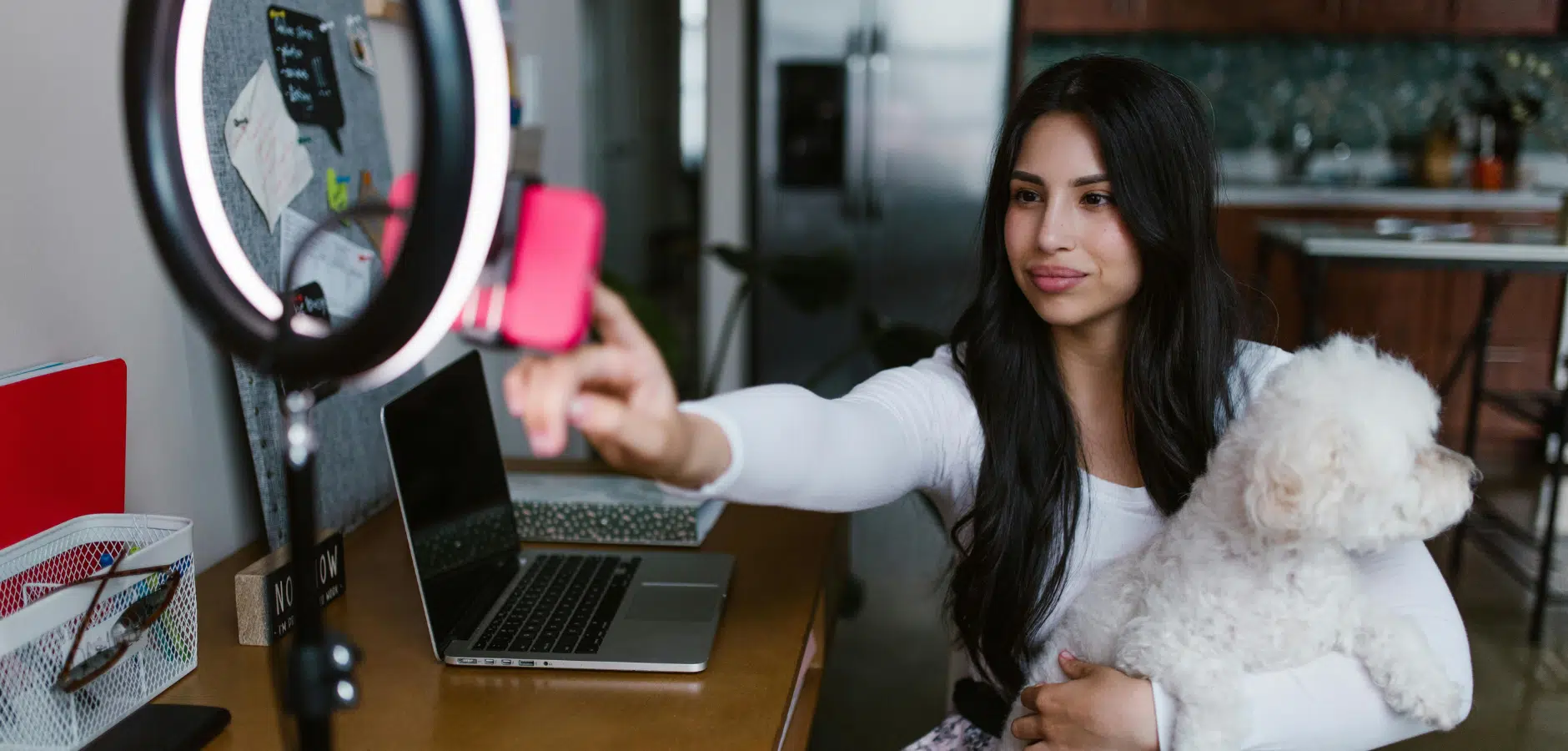Meet Nala, the feline powerhouse who transformed from shelter cat to business empire. With 4.5 million Instagram followers and a Guinness World Record to her name, this influential kitty isn’t just racking up likes—she’s driving serious revenue.
When retail giant Walmart noticed Nala’s extraordinary engagement rates, it didn’t just offer a sponsorship deal. It brought her entire “Love, Nala” premium pet food line to its shelves and website, recognizing the commercial power behind those whiskers and wide eyes.
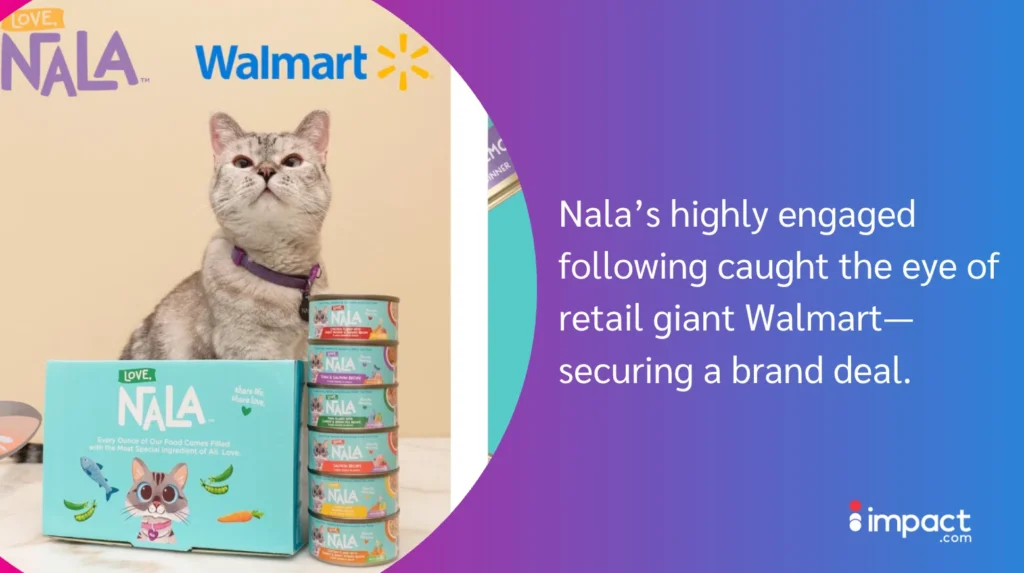
This is the new reality of marketing in 2025: pets aren’t just companions—they’re compelling brand partners with conversion capabilities that often outperform their human counterparts.
This year, U.S. pet owners are expected to spend a staggering $157 billion on their beloved fur babies. For brands across industries—not just pet products—that’s a massive opportunity waiting to be unleashed.
What makes pet influencers so effective? Their universal appeal transcends typical marketing barriers. When a product receives the “paw of approval,” audiences perceive it as authentic.
And here’s what might surprise you: you don’t need to sell pet products to benefit. Industries from fashion and home décor to tech and travel are tapping into this deeply engaged community, using pet partnerships to strengthen brand awareness and open new revenue streams with audiences they might otherwise struggle to reach.
In this blog, you’ll discover:
- Five reasons to invest in pet influencer marketing
- Key considerations before hiring pet influencers
- Three types of pet influencer accounts
- Six steps to create a winning campaign
- Pet influencer marketing examples that worked
- How to tap into new revenue streams with pet influencers
5 reasons brands should invest in pet influencer marketing
The growing influence of pet accounts isn’t just a passing trend—it’s a marketing phenomenon backed by compelling data and results.
Pet influencers like Nala have proven that adorable content translates to serious business impact. When followers see these beloved animals interacting with products, the endorsement feels genuine rather than commercial, creating a trust factor that traditional advertising struggles to achieve.
The commercial potential of these partnerships extends far beyond pet products. Home goods brands showcase their rugs’ durability through playful puppy videos. Tech companies demonstrate product simplicity with cats “unboxing” devices. Travel accessories appear in adventure photos of dogs hiking with their owners.
This versatility makes pet influencer marketing adaptable to nearly any industry looking to connect with consumers on an emotional level.
If you’re still wondering whether this strategy belongs in your marketing mix, consider these five compelling reasons to collaborate with pet content creators.
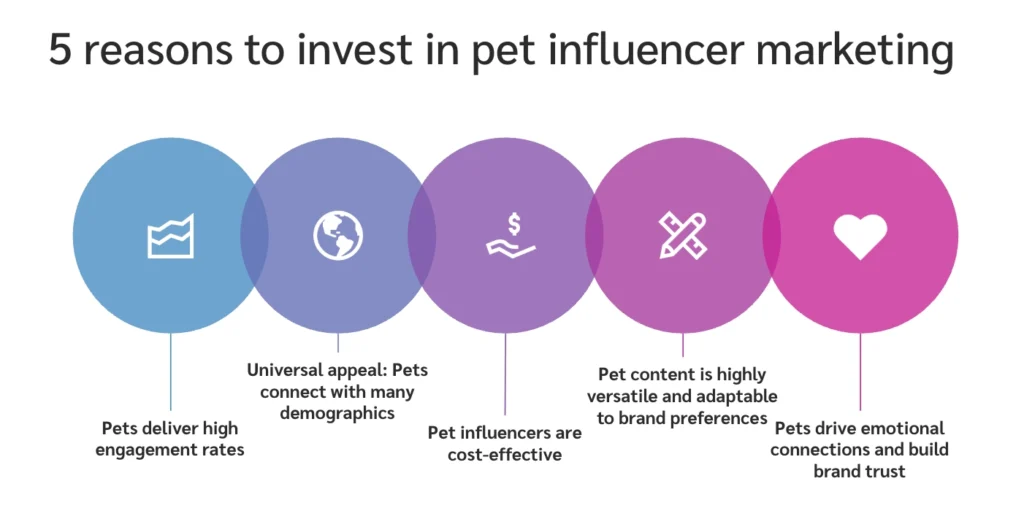
1. Pets deliver high engagement rates
Pet accounts feel relatable, trustworthy, and highly effective at driving action—no surprise, given that people trust what their pets (and favorite pet influencers) love.
According to Sprout Social, pet influencers average 5 percent engagement rates across major social media platforms from March 2024-2025. Considering most influencers have engagement rates between 1 and 3 percent, it’s clear that pet influencers can outperform many of their counterparts.
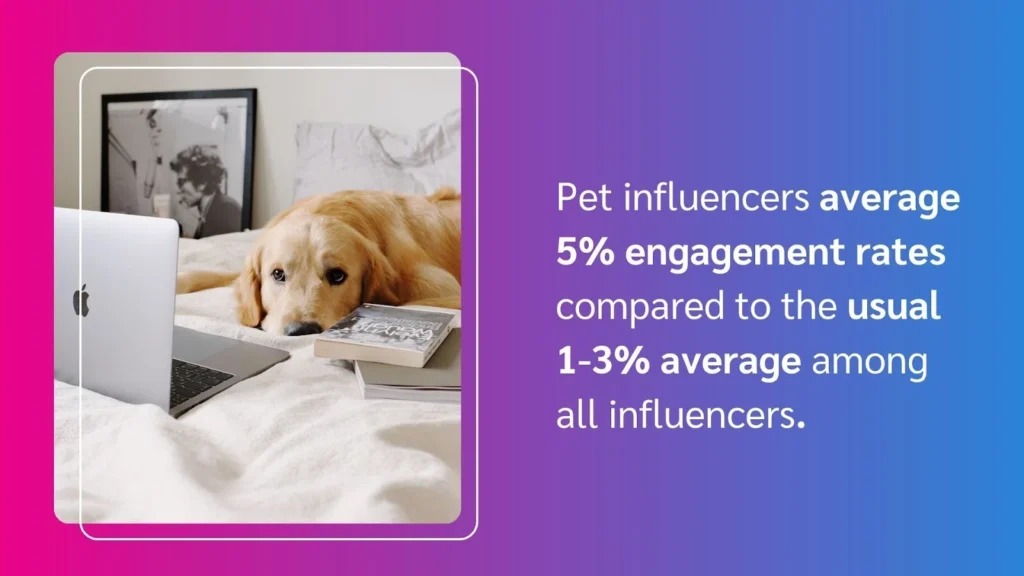
Source: Sprout Social
2. Universal appeal: Pets connect with many demographics
Pet influencers appeal to a wide range of audiences across diverse demographics and interests. According to the American Pet Products Association, nearly two-thirds of pet owners follow at least one pet influencer on social media.
No matter their hobbies, interests, or background, well-rounded pet content appeals to everyone: It feels approachable and, oddly, more human. This universal appeal is a one-way ticket straight into their hearts (and wallets).
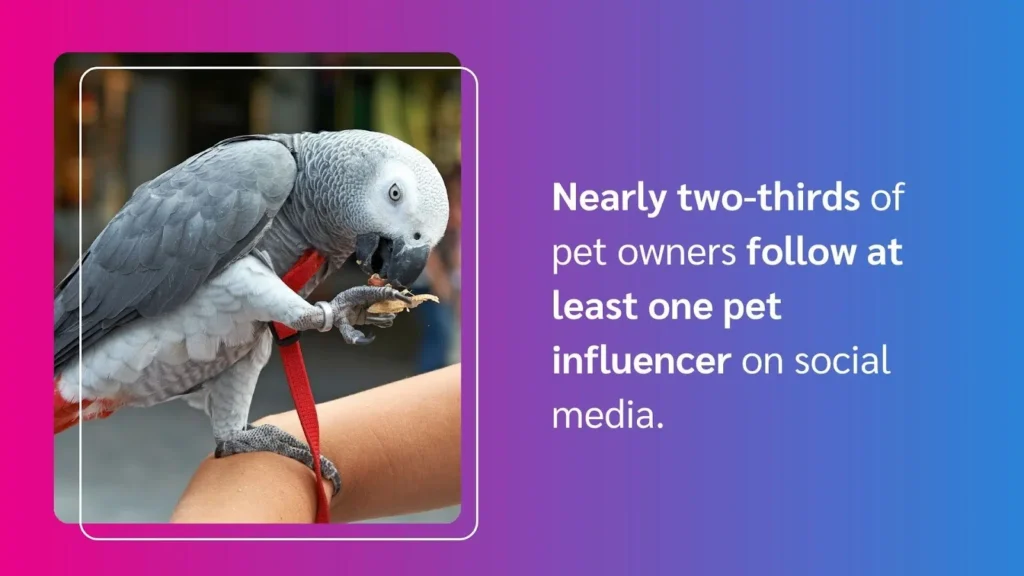
Source: American Pet Products Association
3. Pet influencers are cost-effective
Compared to traditional ads, working with smaller pet influencers is a cost-effective way to reach engaged audiences. According to Sprout Social, the average value of a pet influencer post for brands was $1,719 from March 2024-2025.
Micro-influencers, those with less than 10k followers, often charge less and deliver more impact, thanks to tighter-knit communities that trust their recommendations. Read more on influencer rates here.
4. Pet content is highly versatile and adaptable to brand preferences
Pet content is an engagement powerhouse because it’s fun, light-hearted, and endlessly entertaining. Better yet, it’s versatile, covering various content types such as:
- Silly photos
- Videos of pets performing neat tricks
- Day-in-the-life pet routines
- Pets reacting to viral sounds and trends
- Funny pet voiceovers
- Dance or challenge videos featuring pets
- Creative use of trending hashtags and filters
The creative concepts are endlessly adaptable and fit nearly any industry, from products designed specifically for pets to tech to travel accessories.
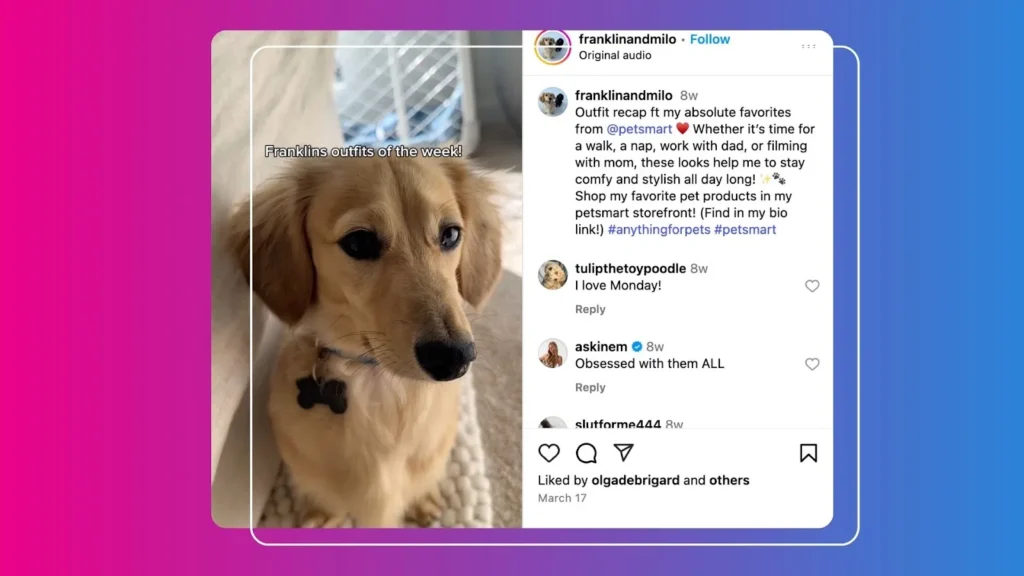
PetSmart partnered up with pet influencer @franklinandmilo to showcase their products in a fun outfit recap Instagram Reel.
5. Pets drive emotional connections and build brand trust
The biggest reason to partner with pet influencers? Emotional connection.
When a product receives the paw of approval, it feels authentic, fosters brand credibility, and comes across as non-commercial.
A 2024 study published in the Journal of Advertising Research discovered that consumers trust pet influencers—not just for their “cuteness,” but also because they’re perceived as more sincere.
Pet-driven content taps into feel-good moments that keep your brand top of mind—especially when it reminds people of their own furry friend. That kind of genuine connection is what turns curious viewers into loyal customers.
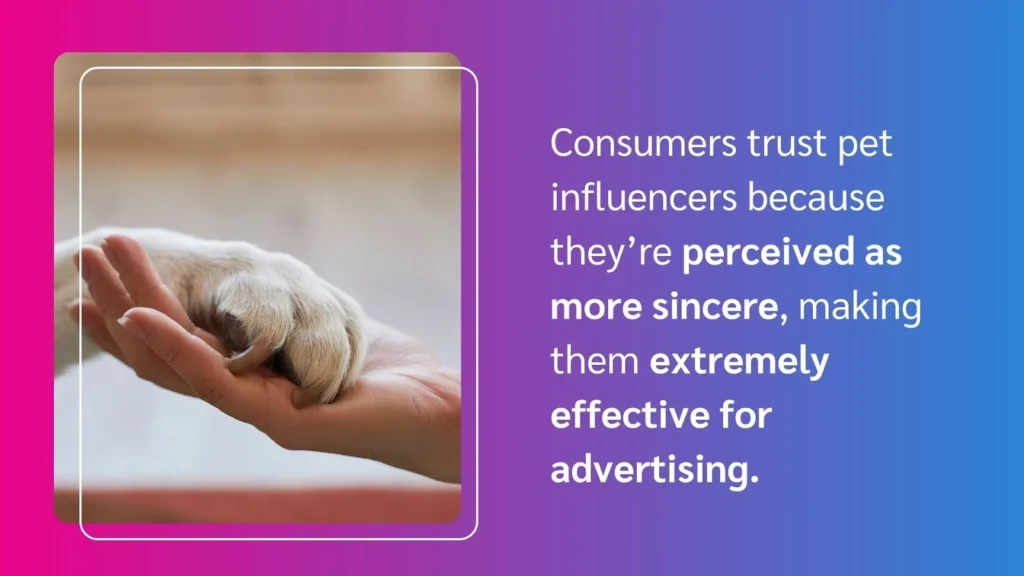
Source: Journal of Advertising Research
Key considerations before hiring pet influencers
To successfully craft winning campaigns with pet influencers, marketers must consider several challenges that are unique to this niche.
Here are some obstacles brands may need to navigate:
- Scrutiny around animal welfare: You may face backlash if audiences perceive that a pet is being exploited or stressed during content creation, so vet your partners wisely.
- Mismatch with serious brand messaging: Many pets have humorous online personas that are better suited for lighthearted campaigns than serious ones.
- Difficulty conveying complex information: Since pets can’t speak and the content is interpreted by owners, it can be difficult for pet-focused accounts to convey more detailed product features or information.
- Potential for unpredictable content: Capturing specific shots or actions depends on the pet’s mood and training, making content creation timelines and outcomes uncertain.
- Heavier lift for non-pet brands: Integrating non-pet products into pet influencer content can work well, but it takes effort and creativity to make it feel natural and relevant.
3 types of pet influencers and their unique brand advantages
Just like human accounts, not all pet influencers are the same (translation: they cater to different audiences). Working with one influencer type may be more effective for your brand than another.
Here’s a breakdown of the three most common types of pet influencer accounts with unique advantages and considerations for brands.
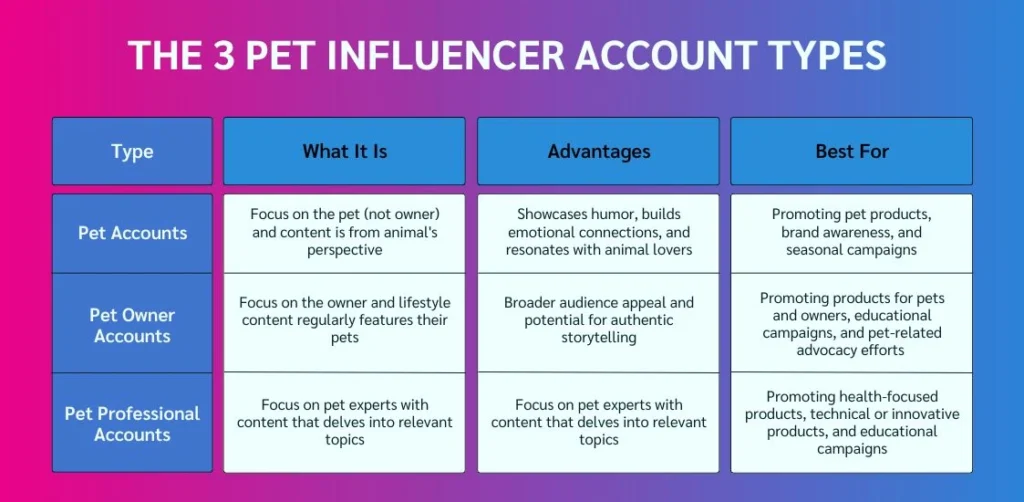
1. Pet accounts
These profiles spotlight the pet, not the owner. Take Nala the cat, whose feed is all about her personality and daily adventures.
Many pet accounts give their animals human-like qualities, such as a voiceover that speaks from the animal’s point of view. This approach can help build trust, as one study showed people find pets more persuasive when they seem to have human-like traits.
Unique advantages for brands:
- Great for showcasing lifestyle, humor, and relatable moments
- Builds emotional connections with pet lovers (and aspiring pet parents)
- Ideal for aligning with specific pet types that match your brand
Best for:
- Promoting pet food, toys, or grooming tools
- Brand awareness campaigns
- Seasonal promos and themed giveaways (such as costumes or treats)

@hi.this.is.tatum, a macro-influencer with over 650k followers, is celebrated for his witty voiceovers. In this post, he collaborates with pet food brand Blue Buffalo to honor National Pet Month.
2. Pet owner accounts
These creators share lifestyle content that regularly features their pets—think a surfer with her dog or a parrot-loving antique shopper. By showcasing the bond between pets and their owners, these accounts offer a unique mix of charm and relatability.
Unique advantages for brands:
- Blend of human and pet content creates broader audience appeal
- Are a great fit for brands beyond the pet industry
- Facilitate authentic storytelling to build emotional resonance
Best for:
- Products and services for both pets and owners (e.g., pet-friendly travel, home goods)
- Educational campaigns on pet care or training
- Advocacy efforts such as rescue pet adoption initiatives

@lizardthebuddy, known as “the friendliest dragon in the world,” has amassed an impressive 1-million-strong following on YouTube. His owner creates engaging content, ranging from expert training tips and terrarium-building guides to charming day-in-the-life videos, making Buddy a beloved star in the reptile community.
3. Pet professional accounts
Creators in the pet care industry mix education with personality, making their content informative and entertaining. Whether they’re veterinarians or dog trainers, these experts’ ability to break down complex topics into accessible, engaging explanations makes them invaluable for educating pet owners while building trust.
Unique advantages for brands:
- Seen as credible, trustworthy sources by their followers
- Ideal for brands looking to build authority and deepen consumer trust
- Great for explaining complex or health-focused products
Best for:
- Health-focused products like supplements or specialty diets
- Educational campaigns backed by professional insight
- Trust-building for technical or innovative pet solutions
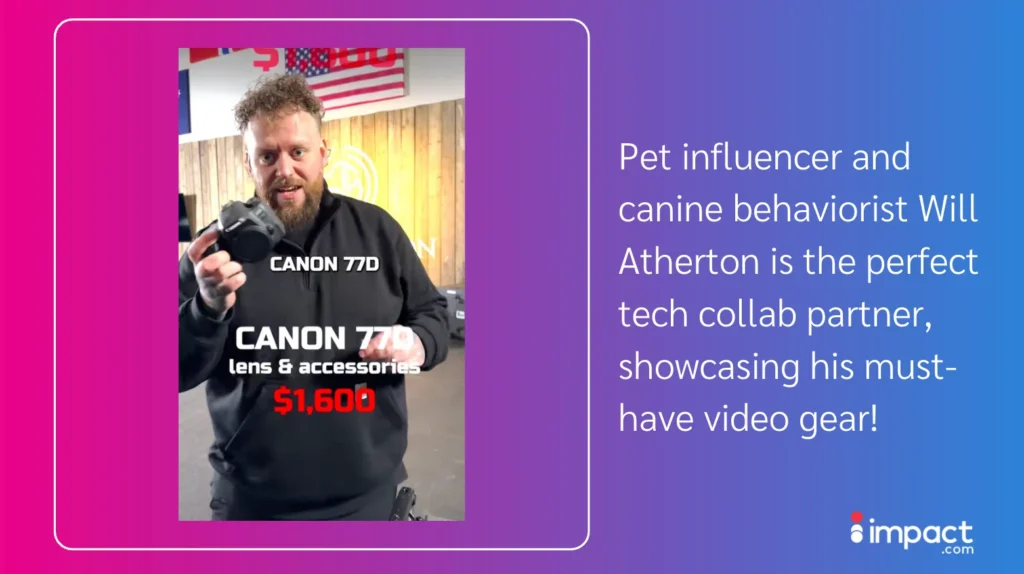
With over two million combined followers across Instagram, YouTube, and TikTok, canine behaviorist Will Atherton knows a thing or two about content creation and the best video gear.
How to build a winning pet influencer marketing campaign in 6 steps
Partnering with pet influencers is a clever way to get your brand in front of a dedicated audience. However, you need a solid marketing campaign to tap into their unique charm, highlight your brand, and drive real results.
Here’s your step-by-step guide to creating a campaign that taps into the magic of pet influencers and aligns with your brand’s goals.
Step 1. Find the right influencers for your brand
Choosing the right pet influencers goes beyond follower count. Research from impact.com highlights that good working relationships are a top priority for brands and creators. The most successful partnerships thrive on alignment—shared values, overlapping target audiences, and genuine, authentic content.
When done right, this alignment strikes a balance between credibility and reach, making your campaigns connect with audiences.
Identify pet influencers that align with your brand and product/service
Relevance is the foundation of any successful influencer partnership. Narrow your search to pet creators whose voice, style, and audience match your brand.
Social listening can also be a valuable tool for finding influencers who already love using your product. Partnering with these authentic advocates feels more genuine, making people more likely to trust the recommendation.
If you find natural connections—whether it’s the product or other elements—your message is more likely to resonate with their followers because it fits naturally into the creator’s existing narrative.
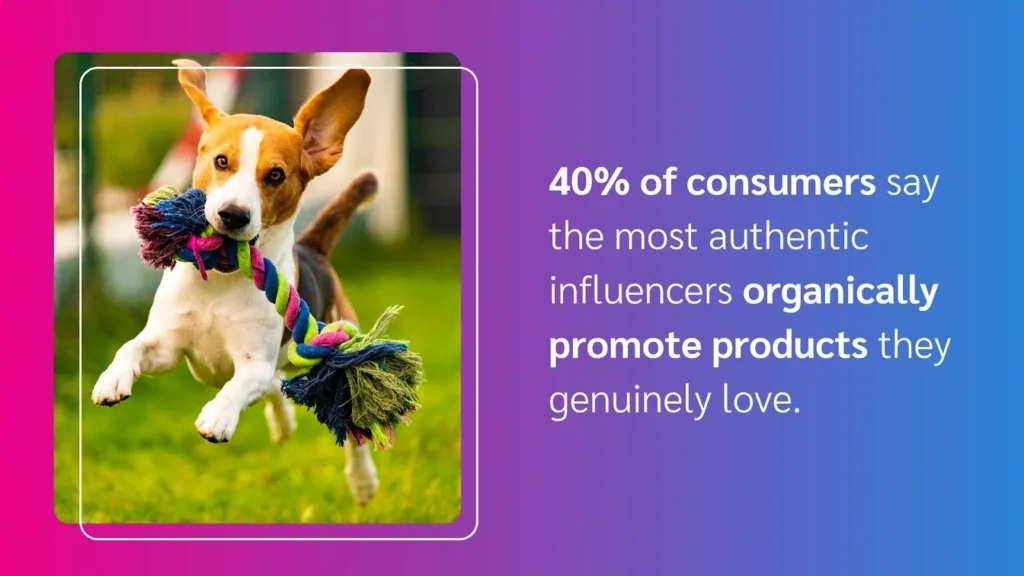
Source: The state of influencer marketing for consumers
Look beyond the animal itself and focus on the content’s broader appeal. If the creator has a golden retriever with a knack for hilarious how-to videos or a cat with a minimalist aesthetic, align those traits with your campaign goals.
For example, a tech brand might engage an influencer with a dog who “reviews” gadgets, while a travel brand could seek out creators with pets often featured in outdoor adventures.
Assess the influencer’s analytics and engagement
Not all engagement is created equal. Before reaching out, take a closer look at performance metrics and go beyond basic numbers (i.e., likes and views).
Pay attention to:
- Engagement rates
- The authenticity of their followers
- The quality of interactions on their posts
For example, do their followers share enthusiastic, specific responses, or leave unengaged, one-word comments?
Search for creators who spark genuine conversation—not just inflated numbers. The right tools can help you verify audience quality before investing.
Start small with micro-pet influencers
Don’t let their audience size fool you—micro influencers are perfect brand collaborators. Their small but loyal audience trusts their opinion and is likely to act on their recommendations.
Nano- and micro-influencers have consistently outperformed their larger counterparts for years. This means higher engagement rates for your campaigns.
Here’s how to collaborate effectively with micro-influencers:
- Identify micro-influencers whose audience matches your brand’s values and target demographic.
- Offer a thoughtful gifting experience—send personalized products or samples to show appreciation and allow influencers to authentically experience your brand.
- Start with small, trackable campaigns to measure engagement and conversions, helping you assess ROI before scaling.
- Gradually grow your campaigns by focusing on your top-performing influencer partnerships, using their success as a blueprint for future collaborations.
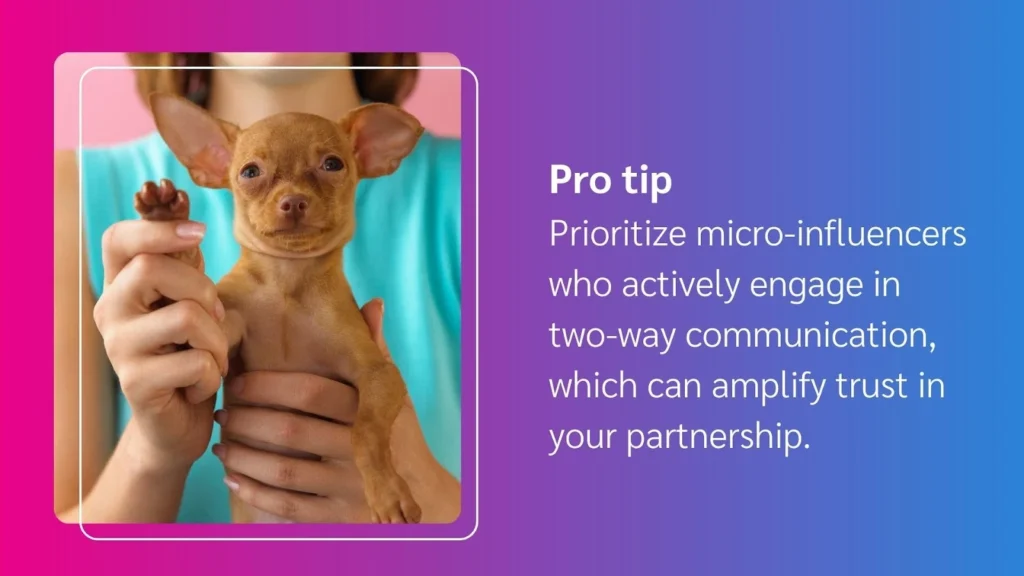
Step 2. Craft authentic campaign messaging
Authentic messaging starts by letting the influencer’s voice lead. A strong partnership doesn’t force your brand’s specific tone—it gives the influencer space to connect with their audience in a way that feels true to them.
Campaigns that don’t scream “ad!” can:
- Build audience trust
- Drive conversions
- Generate leads without feeling pushy or overly produced
Start by skipping the fully written brief. Bring your influencers in early and give them creative freedom to shape the concept. They know what makes their audience tick and they know what makes their pets shine.
By co-creating content, you end up with more shareable (and memorable!) posts that center the pet’s personality—the exact thing their audience loves most.
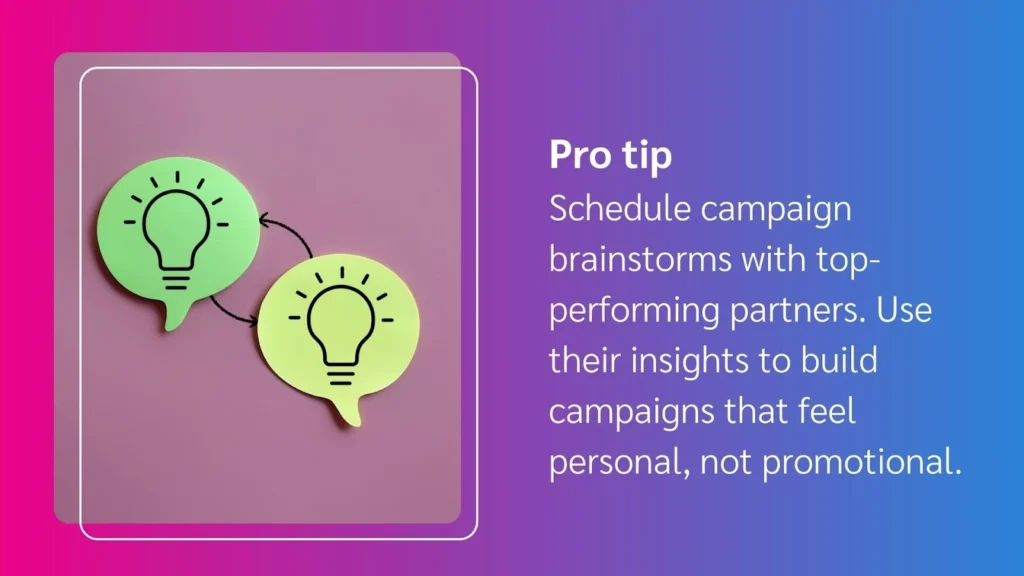
Step 3. Provide clear guidelines (without sacrificing creative freedom)
From an influencer’s perspective, partnering with a clear and organized brand makes all the difference. Well-defined expectations lead to smoother collaborations, maximized opportunities, and a positive experience that strengthens your brand’s reputation in the creator community.
Provide clear goals, key performance indicators (KPIs), and brand messaging upfront to set creators up for success. Giving them the tools they need minimizes roadblocks and builds strong, lasting partnerships.
Be clear about content expectations, such as:
- Hashtags
- Posting schedules
- Required branding or talking points
- Do’s and don’ts for content delivery
Clarity drives better content, and better content translates to stronger campaign performance.
You also want to provide compliance guidelines to ensure the influencer follows FTC regulations and brand guidelines, helping them maintain consumer trust.
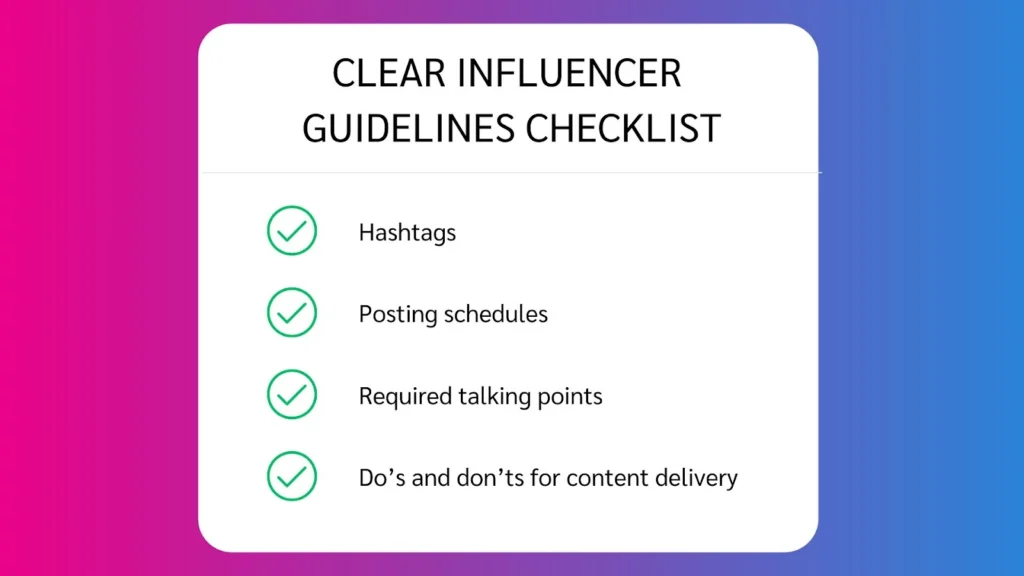
At the same time, give creators the freedom to do what they do best. Creative freedom allows ideas to flourish and results in more authentic content. When you trust creators and avoid micromanaging, you empower them to bring their unique magic to the table.
Content creator Tina Angelina emphasizes the value of authenticity, highlighting that audiences now crave genuine connections with influencers. She notes that the era of overly polished, heavily edited videos is a thing of the past.
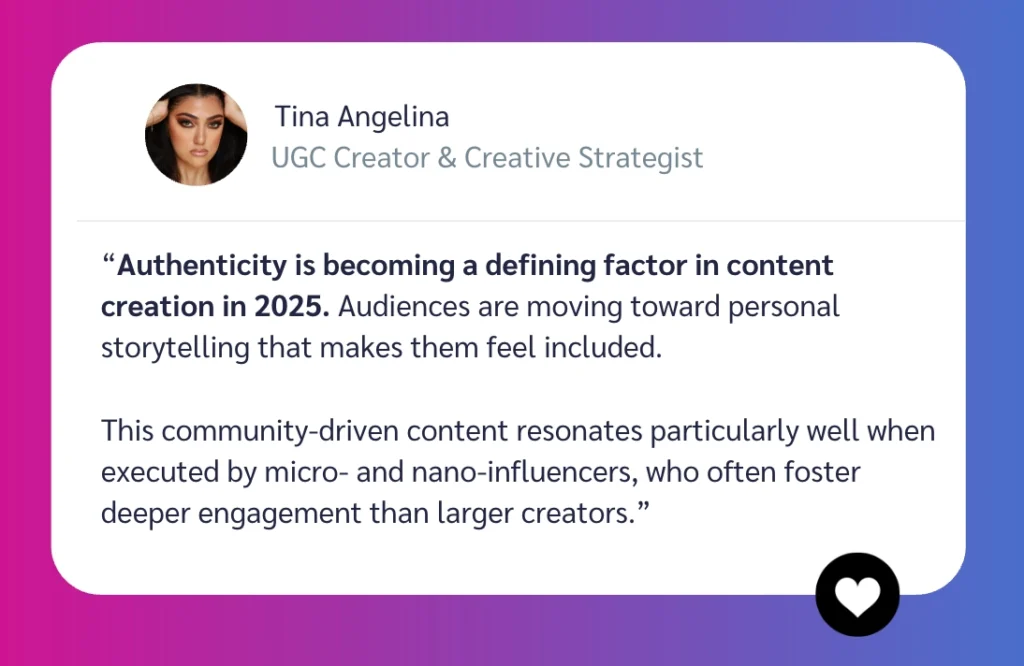
According to content creator Tina Angelina, the perfect balance of clear guidelines and creative freedom is essential for producing authentic content that captivates and engages audiences.
Step 4. Track campaign performance in real-time
Tracking a campaign’s performance in real-time is arguably the most critical step of any influencer marketing strategy.
Performance data highlights where you can optimize for stronger results. With the right metrics, you can compare against benchmarks, evaluate ROI, and identify trends that shape future campaigns.
Use metrics to inform your next steps and:
- Analyze campaign metrics to identify what resonates with your audience
- Plan posts around peak engagement windows (think holidays) for maximum visibility
- Refine your CTAs to capture more conversions
- Monitor performance to see which influencers are driving results
- Sunset underperforming creators to focus on impactful partnerships
- Introduce tiered benefits to reward high-performing influencers
- Test different content formats to find what works best for your brand and audience
Don’t “set it and forget it.” Monitor key metrics—like reach, engagement, and conversions—while the campaign is live. This gives you space to pivot and support influencers with real-time feedback.
Just remember: not all audiences behave the same. Each influencer brings unique types of engagement. Keep an open feedback loop and adjust your strategy to better support your goals and your partners.
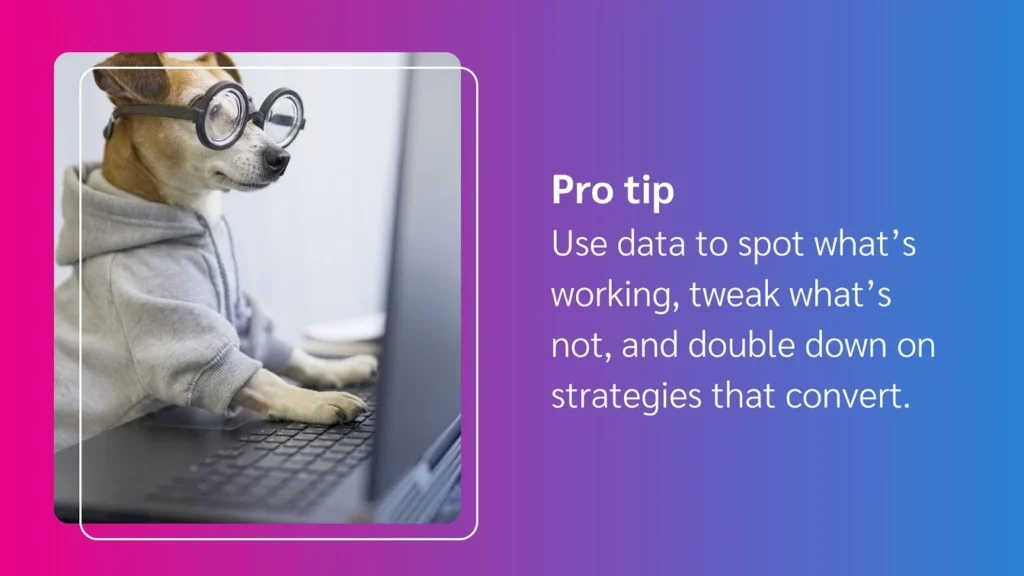
Step 5. Build mutually beneficial partnerships
A profitable long-term influencer partnership benefits all parties involved:
- For brands: Offers high-impact exposure to an audience already primed to buy.
- For creator partners: Increased visibility, stronger community trust, and the potential for ongoing revenue.
To encourage long-lasting partnerships, prioritize transparency, share performance data openly, and offer flexible incentive models, such as affiliate commissions or revenue-sharing arrangements.
When creators feel valued and supported, they become true brand advocates—not just one-off sponsors.
Pro tip: Test a mix of compensation models to find what drives the most engagement, participation, and loyalty. Marketing trends indicate a preference and increasing use of hybrid compensation models.
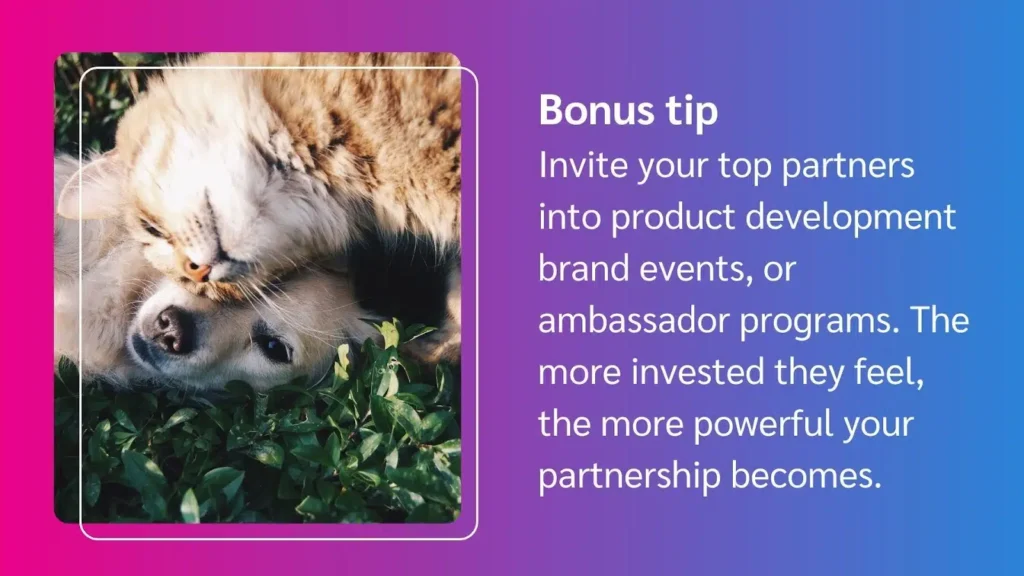
Step 6. Promote and repurpose influencer content
Collaborating with partners is a team effort. While they bring an engaged audience, you can amplify the impact of their content as a brand.
As you’re putting together your contract, consider negotiating for usage rights. Usage rights allow you to repurpose the influencer’s posts across your own channels—also sometimes called user-generated content (UGC). This approach stretches your budget, boosting campaign reach while providing the influencer more visibility.
By showcasing your partner’s work, you create more value for both sides and strengthen the partnership. Plus, nurturing smaller partners now lays the foundation for attracting even bigger collaborations in the future, including top pet influencers. It’s a win-win!
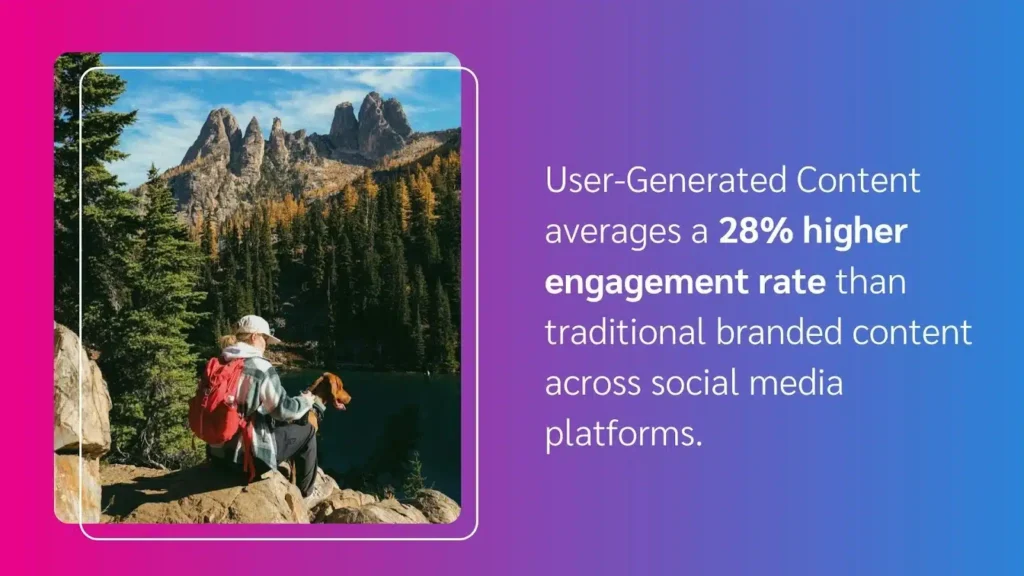
Source: Comscore
Fur-tastic pet influencer marketing examples that work
It’s helpful to see successful partnerships between brands and influencers in the animal niche to get a better idea of what’s possible.
Here are four examples of collaborations with animal enthusiasts and their furry friends that pet lovers everywhere want to see in their feeds.
Vito the boxer x Stella & Chewy
Vito and Rocco (@vito.the.boxer), two boxers living their best lives, have amassed 80k+ followers on Instagram. Their owners share cutesy photos of the duo, including holiday-themed costumes and pictures of their mischievous antics.
And when it comes to pet influencer marketing, Vito and Rocco do it right.
As a mid-tier petfluencer, Vito takes his followers through a hilarious morning routine featuring his favorite @stellaandchewys meal. This Instagram Reel cleverly mirrors the style of human influencers sharing their own routines, adding a humorous twist on a traditional format.

Source: @vito.the.boxer
Why it works
Stella & Chewy’s product range—from kibble to toppers and wet food—is seamlessly showcased without feeling like a traditional ad. The playful content blends perfectly with the video’s comedic tone, making the promotion feel natural and engaging.
And because the product isn’t front and center, it feels more authentic, leading viewers to believe the pet food is really part of Vito’s routine.
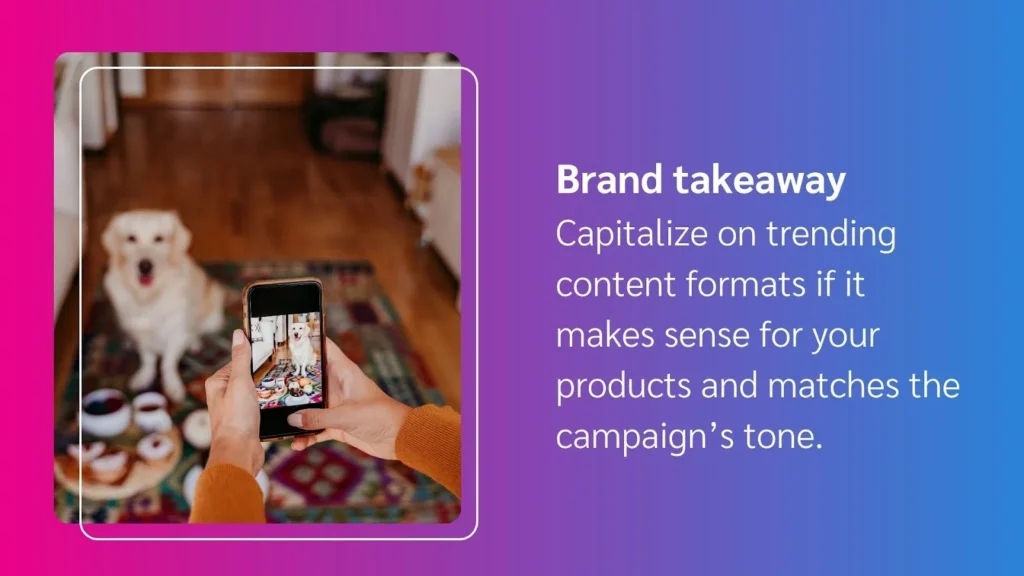
Jordan + Akira x PetSmart
Jordan and Akira (@myhuskytale) are nano-influencers who fall firmly into the pet-owner category. Jordan shares her life with her audience, including her love for books, while weaving in content related to her dog, Akira, and her cat.
Although Jordan’s audience expects to see content centered on reading and mental health, promoting their shoppable PetSmart storefront in this YouTube Short just makes sense.

Source: @myhuskytale
The video immediately highlights a key pet owner benefit: the convenience of snagging great deals on pet supplies from home (even if Akira prefers in-store adventures).
Why it works
Featuring Akira grabs viewers’ attention and keeps them engaged by emphasizing how easy it is to shop from home. The clip offers a sneak peek into the PetSmart branded storefront, showcasing a wide range of products paw-selected by Akira for every need.
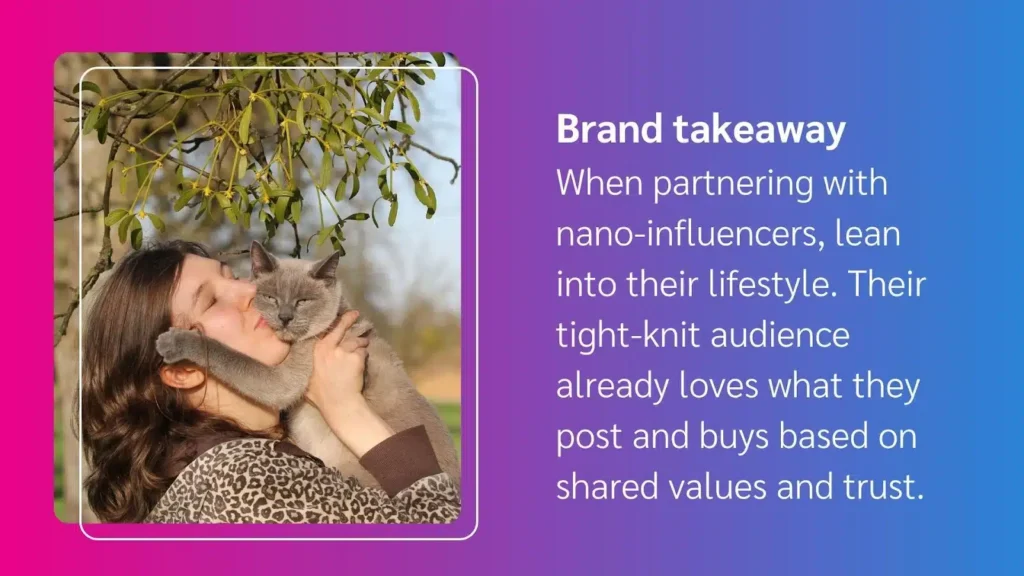
McKenna Gehrke x Rocco & Roxie
McKenna Gehrke (@mckennagehrke), not typically known as a pet influencer, steps into the role by featuring her furry companion in this Instagram Reel for Rocco & Roxie’s stain and odor remover.
The video showcases a relatable moment for pet owners—navigating muddy pawprints after a walk—with McKenna demonstrating how the product swiftly resolves the mess.
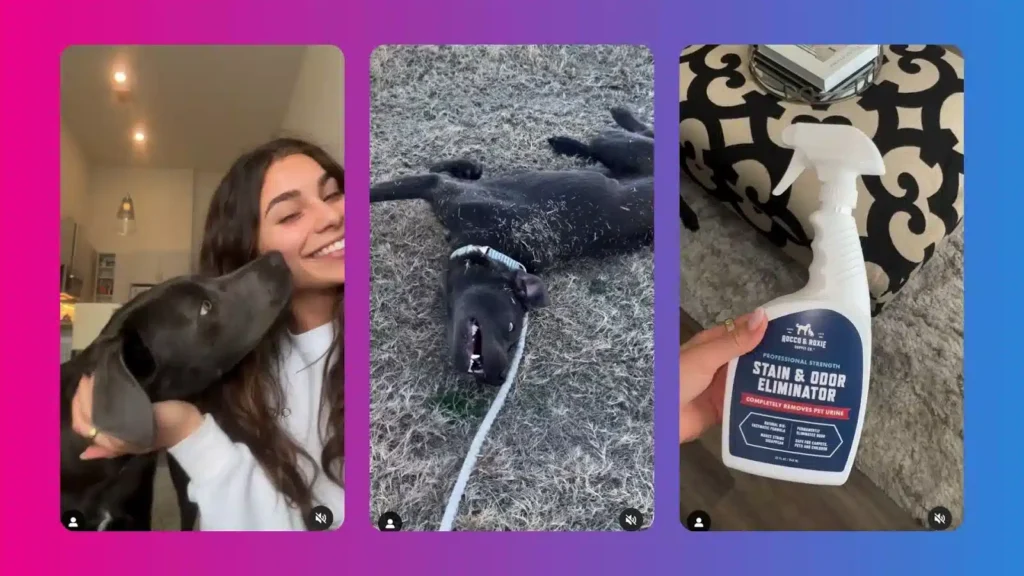
Source: @mckennagehrke
Although McKenna isn’t a pet influencer, her audience follows her because they’re interested in the day-to-day aspects of her life, which include her pets. So, for the pet enthusiasts who do follow her, this post resonates.
And for non-pet people who follow her for other reasons? It builds brand awareness, keeping the product front and center for other messes.
Why it works
By spotlighting her dog, McKenna bridges the gap between her usual audience and pet-centered content, broadening the product’s appeal.
For a brand like Rocco & Roxie, leveraging an influencer outside the pet niche adds novelty and freshness, while still connecting deeply with pet owners.
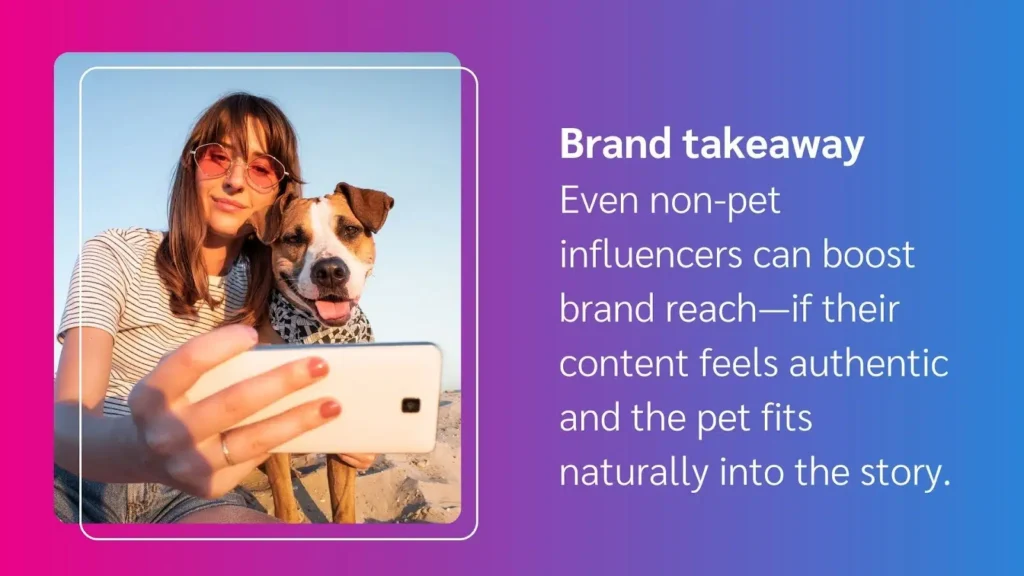
Sir George x Bissell
Sir George (@sirgeorge), a fluffy ragdoll cat, keeps his audience entertained by his humorous antics.
So, when he promoted the BISSELL Little Green HydroSteam in this Instagram Reel, it felt natural due to the video’s initial setup.
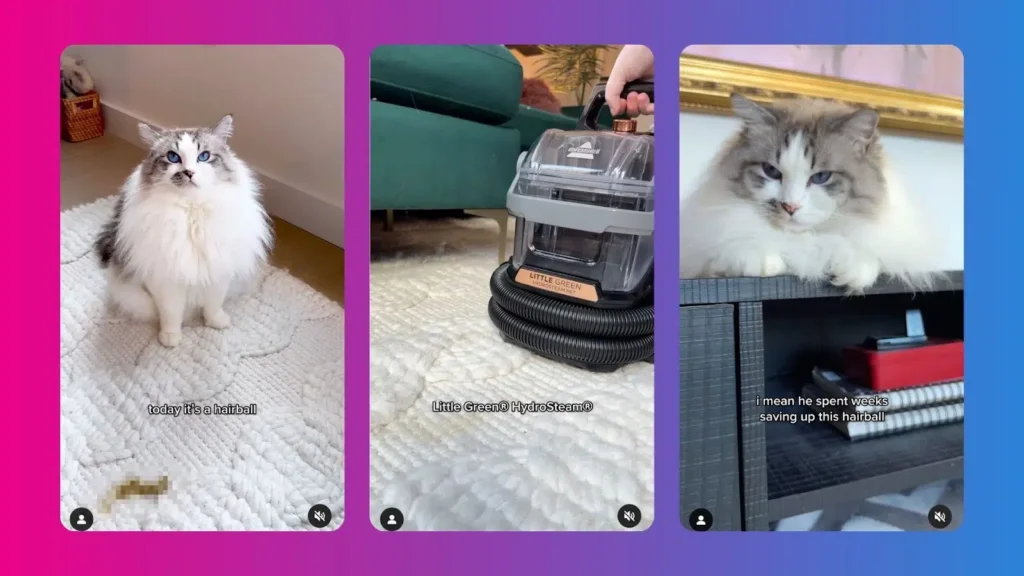
Source: @sirgeorge
The ad highlights the product’s ability to tackle tough pet messes, like sticky or oily stains, while keeping carpets pristine, even with George’s mischievousness on full display.
For pet owners with similar antics-loving critters, this ad is all too relatable.
Why it works
This ad blends functionality with charm and humor. Sir George’s playful personality makes the post both entertaining and relatable, while the focus on the product’s performance reinforces its effectiveness for pet lovers who deal with messes.

Tap into new revenue streams with pet influencers
Pet influencer marketing is more than a trend. It’s a proven, powerful strategy for building authentic connections with new audiences, tapping into new revenue streams, and driving brand awareness.
With high engagement rates, broad appeal, and emotionally resonant content, pet creators offer brands unique opportunities to connect with their audiences where they are most receptive.
Whether you’re testing the waters with micro-influencers or scaling a campaign with top-tier furry stars, the key is to cultivate genuine partnerships and actionable strategies backed by data.
FAQs
Pet influencers are social media accounts centered on animals. They come in three main types:
- Pet-focused accounts showcasing the animal’s personality
- Owner-focused accounts combining pet and personal stories
- Professional accounts offering expert pet care advice
Each type creates unique emotional connections with followers. For brands, this means opportunities to craft emotional campaigns, build relatable content, or forge trusted educational collaborations. Partnering with the right pet influencer can drive engagement and connect authentically with pet-loving audiences.
Many pet brands regularly work with influencers, ranging from niche startups to household names. This includes brands like PetSmart, Chewy, Rooco & Roxie, and BISSELL.
However, it’s not just pet-related brands that can benefit from these partnerships. The appeal of pets transcends industries, making them a powerful tool for connecting with diverse audiences. Industries such as home decor, lifestyle, fitness, travel, tech, and even fashion have successfully collaborated with pet influencers to promote their products or services.
From showcasing a cozy rug in a stylish living room to featuring pet-friendly travel gear or even tech gadgets for pet care, these partnerships add a relatable, heartwarming touch to any brand’s marketing strategy.
You can find pet influencers by searching hashtags like #dogsofinstagram, #catsoftiktok, or #petfluencer. However, the easiest way to find pet influencers is to use influencer discovery platforms like impact.com’s Creator, which lets you filter prospective partners by niche, location, and engagement.
You can leverage influencer marketing by partnering with pet influencers to showcase your products in real, relatable ways that resonate with pet-loving audiences. Then repurpose that content across your marketing channels to maximize reach and ROI.
To make the most of this strategy, focus on micro-influencers who have highly engaged, niche audiences. Offer personalized discount codes or giveaways to track conversions and further engage their followers.
Additionally, prioritize building long-term relationships with high-performing influencers to create authentic partnerships that strengthen your brand’s credibility among target demographics.
